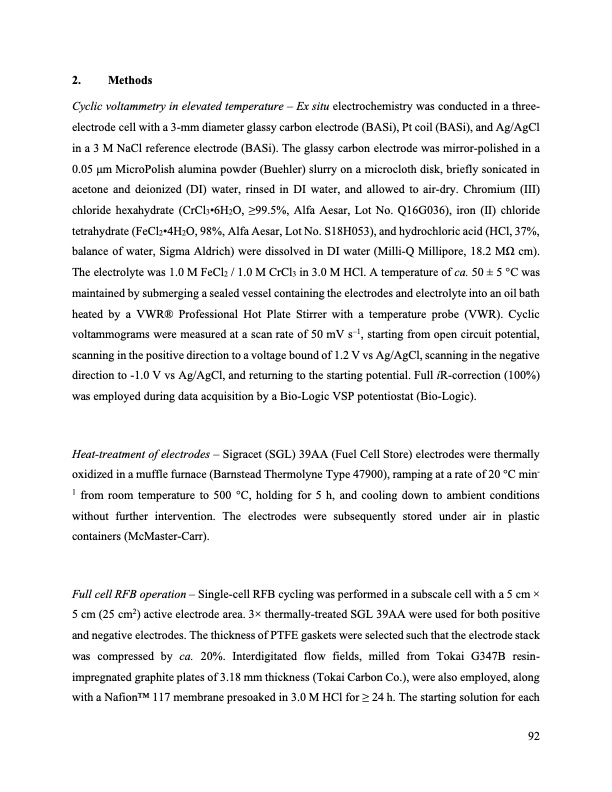
PDF Publication Title:
Text from PDF Page: 092
2. Methods Cyclic voltammetry in elevated temperature – Ex situ electrochemistry was conducted in a three- electrode cell with a 3-mm diameter glassy carbon electrode (BASi), Pt coil (BASi), and Ag/AgCl in a 3 M NaCl reference electrode (BASi). The glassy carbon electrode was mirror-polished in a 0.05 μm MicroPolish alumina powder (Buehler) slurry on a microcloth disk, briefly sonicated in acetone and deionized (DI) water, rinsed in DI water, and allowed to air-dry. Chromium (III) chloride hexahydrate (CrCl3•6H2O, ≥99.5%, Alfa Aesar, Lot No. Q16G036), iron (II) chloride tetrahydrate (FeCl2•4H2O, 98%, Alfa Aesar, Lot No. S18H053), and hydrochloric acid (HCl, 37%, balance of water, Sigma Aldrich) were dissolved in DI water (Milli-Q Millipore, 18.2 MΩ cm). The electrolyte was 1.0 M FeCl2 / 1.0 M CrCl3 in 3.0 M HCl. A temperature of ca. 50 ± 5 °C was maintained by submerging a sealed vessel containing the electrodes and electrolyte into an oil bath heated by a VWR® Professional Hot Plate Stirrer with a temperature probe (VWR). Cyclic voltammograms were measured at a scan rate of 50 mV s–1, starting from open circuit potential, scanning in the positive direction to a voltage bound of 1.2 V vs Ag/AgCl, scanning in the negative direction to -1.0 V vs Ag/AgCl, and returning to the starting potential. Full iR-correction (100%) was employed during data acquisition by a Bio-Logic VSP potentiostat (Bio-Logic). Heat-treatment of electrodes – Sigracet (SGL) 39AA (Fuel Cell Store) electrodes were thermally oxidized in a muffle furnace (Barnstead Thermolyne Type 47900), ramping at a rate of 20 °C min- 1 from room temperature to 500 °C, holding for 5 h, and cooling down to ambient conditions without further intervention. The electrodes were subsequently stored under air in plastic containers (McMaster-Carr). Full cell RFB operation – Single-cell RFB cycling was performed in a subscale cell with a 5 cm × 5 cm (25 cm2) active electrode area. 3× thermally-treated SGL 39AA were used for both positive and negative electrodes. The thickness of PTFE gaskets were selected such that the electrode stack was compressed by ca. 20%. Interdigitated flow fields, milled from Tokai G347B resin- impregnated graphite plates of 3.18 mm thickness (Tokai Carbon Co.), were also employed, along with a NafionTM 117 membrane presoaked in 3.0 M HCl for ≥ 24 h. The starting solution for each 92PDF Image | Bringing Redox Flow Batteries to the Grid

PDF Search Title:
Bringing Redox Flow Batteries to the GridOriginal File Name Searched:
Rodby-krodby-phd-chemE-2022-thesis.pdfDIY PDF Search: Google It | Yahoo | Bing
Salgenx Redox Flow Battery Technology: Salt water flow battery technology with low cost and great energy density that can be used for power storage and thermal storage. Let us de-risk your production using our license. Our aqueous flow battery is less cost than Tesla Megapack and available faster. Redox flow battery. No membrane needed like with Vanadium, or Bromine. Salgenx flow battery
| CONTACT TEL: 608-238-6001 Email: greg@salgenx.com | RSS | AMP |